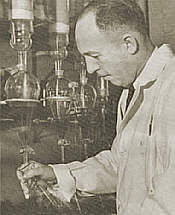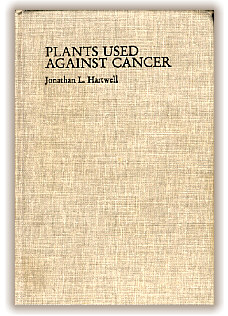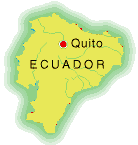
 1906 - 1991
1906 - 1991
Born: 1906 (Boston, MA)
Died: March 22, 1991 (Wash., D.C.)
 The untimely death of the cancer screen
The untimely death of the cancer screen
I'm here to eulogize:
The screen's mean genes were not foreseen
They, too, would metastasize.
 Anonymous poet Anonymous poet


The quotation on the previous page
was taken from a rare book,
entitled Plants Used Against Cancer* by Dr. Jonathan L. Hartwell,
who worked at the National Cancer Institute from 1938 (in fact,
according to Ralph W. Moss, was
one of
its founders) until his
retirement from the NCI's Natural Products Section (which he
also founded) in 1975.
He studied botanical sources for cancer treatment for most of
his career. The book was published in 1981 by Quarterman
Publications in Lawrence, Massachusetts, and although it
is Hartwell's most quoted work and it's probably safe to say
it was his "magnum opus," it still was one of only a hundred
or more papers and books which Hartwell authored.
 Not long after
the book was published Quarterman Publications went out
of business and Dr. Hartwell died. We own
an original hardbound copy of the book and keep it at our offices.
 Jonathan Hartwell was born in 1906
and educated at Harvard. He earned in bachelor's degree in 1927;
master's in 1929; and a doctorate in 1935. He was employed by
both DuPont and Interchemical Corporation before his association
with the National Cancer Institute in 1938. As head of the National
Products Section, Hartwell devoted himself to the reserach and
administration of cancer research. He was honored with a seat on
the editorial board of the Journal of Ethnopharmacology as
well as membership in the professional societies: the American
Chemical Society, the American Society of Pharmacognosy, the
Society for Economic Botany, and the Phytochemical Society
of North America. Hartwell died on March 22, 1991 in
Washington, D.C., where he resided with his wife, Ann.

We feel that the following quotation, taken from the book's
foreword by Jim Duke, is a story worth telling. As you read
this excerpt, remember that it was written in January, 1982:
"... I view [Jonathan's book] as one epitaph to the cancer-screening
program involving the National Cancer Institute with the U.S.
Department of Agriculture for nearly 25 years. In a blow to
natural-products chemistry in the United States, the Board of
Scientific Counsellors, Division of Cancer Treatment, National
Cancer Institute, voted on October 2, 1981, to abolish the NCI
research contract program concerned with the development of
antitumor agents from plants. I fear this signals the end of
significant government-sponsored research in the United States on
medicinal plants, leaving research to the pharmaceutical firms,
who have shown relative disinterest in plant products.
According to the OTA (Office of Technology Assessment, 1981) Project
Proposal, approved by Congress, Technologies for Sustaining
Tropical Forest Resources (p. 15), "The National Cancer Institute has
screened about 35,000 higher plants species for activity against
cancer; as of 1977 about 3,000 of these had demonstrated
reproducible activity; a small fraction were appropriate for
screening should perhaps be accelerated." Apparently, Congress
had not anticipated the closing down of the plant screening
program. In 1978, as a longtime student of herbal medicine,
I changed places with Dr. R.E. Perdue as leader of the Medicinal
Plant Resources Laboratory of the USDA. Although no exciting
new leads developed during my association with the program, they may
well reside untested in the hundreds of plant specimens that came in
from Australia, China, Ecuador, Madaagascar, and Venezuela after
the program was ordered phased out. I fear that the long-range
implications are that, as a result of this cutback, some plant
species with anticancer activity will suffer extinction before
they are ever studied. Some natural drugs that could save
thousands of lives and alleviate much suffering will disappear
from the face of the earth, irretrievable,
without ever being used...
Dr. Wilburn H. Ferguson &
The Suppression of Ammatosin
 We are aware of a number of cases involving
Jonathan Hartwell's work -- where higher-appointed authorities within the
NCI, acting in concert with friends in the pharmaceutical industry, would
squash a project that showed real promise in the area of cancer research.
One of these was an herbal project called "ammatosin," developed over a twenty
year period by a phytopharmacologist who has been reported to be the
original inspiration behind the movie, Medicine Man (1992),
Dr. Wilburn H. Ferguson. [The fictional story, however, takes place
in neighboring Brazil.]

 As the story is told by Ferguson
family members, Wilburn went to the Amazonian jungles of eastern Equador in
the 1950's to research a herbal product that was reported to cure cancer
in all but the rarest of cases. He spent about twenty years reducing
the formula, which was part of the oral ethnobotanical pharmacopaeia
of the Jivaro indians, from 35 herbs down to 7 -- in other words, he
left in the formula only those herbal components which were shown to
make a contribution to the cancerolytic process.
 A series of clinical human
studies were initiated, all of which demonstrated that the product worked
as well as any control pharmaceutical to which it was compared.
(One set of clinicals were conducted in Pama Valley, California -
1959-1960; to be followed by other clinicals that produced
similar results). Dr. Hartwell was first notified of these results
by Professor John Harris in a letter dated April 6, 1971 -- upon
which Hartwell began investigations of his own. Ferguson attempted to
get funding from George Zimmer (owner of Men's Warehouse in Houston),
but was unsuccessful.
 Hartwell was asked to drop the
investigation, funding was never obtained as a result of a lack of
any "official" approval, and today, the product is made privately
by members of the Ferguson family -- who refuse to do anything
further to bring the formula to the public for fear of reprisal
from regulatory agencies.
 Such is the legacy of the
best minds in natural, alternative botanical solutions to cancer
treatment in the modern age. And no such list could be properly
compiled without including the name of Jonathan Hartwell.
Footnotes & Relevant Links
* --- Plants Used Against Cancer was published in hardbound in 1982 by
Quarterman Publications, Inc. (last address of record: 5 South Union Street,
Lawrence, Massachusetts 01843). We went to great lengths to contact any
remnants of Quarterman in early 1993 -- to no avail. Their last phone
number was (508) 689-0207, and the offices were in a structure known
as the "Ere Mill Building." We could find no one who would admit
knowing anything about the company in Lawrence. For the record, the
book copyright page reads, "This work is a facsimile compilation of
the serialization entitled, "Plants Used Against Cancer. A Survey"
by Jonathan L. Hartwell which appeared in Lloydia in eleven
installments between 1967 and 1971. The original text has been
reproduced chronologically with the pages renumbered consecutively.
A forward has been added to this edition." [by Jim Duke, dated
January, 1982] Plants Used Against Cancer was part of
a two volume "Bioactive Plants" series published by Quarterman. The
first volume was called Medicinal Uses of Plants by
Indian Tribes of Nevada by Percy Train, James R. Hendrich,
and W. Andrew Archer. Additional identifying information on
Plants Used Against Cancer includes the following:
 Library of Congress Catalog Number: 81-85230
International Standard Book Number: 0-88000-130-5
Printed in the United States of America
 Herbalgram article
Herbalgram article on Hartwell
 Chinese Tree Extract
Chinese Tree Extract -- a valuable
cancer-fighting botanical source, the discovery of which was
a Hartwell contribution
 Hartwell and the Yew Tree discovery
Hartwell and the Yew Tree discovery
 Comments on his work
Comments on his work in uncovering
plant-based cancerolytics
 Comments
Comments on Jonathan
Hartwell by Ralph W. Moss
 The Hoxsey Formula
The Hoxsey Formula --
Hartwell founded cancer-fighting properties in virtually all the herbs used
in the much maligned internal Hoxsey formula.
AO Home Page |
Back to "Supression" Reference |
Order Form
|


 The untimely death of the cancer screen
The untimely death of the cancer screen 

 Library of Congress Catalog Number: 81-85230
Library of Congress Catalog Number: 81-85230